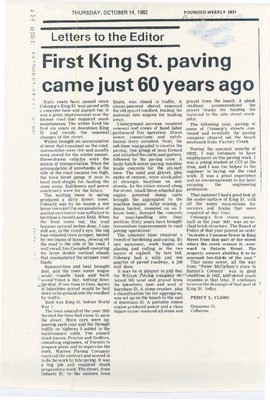Sixty years have passed since Cobourg’s King St. was paved with a concrete base and asphalt top. It was a great improvement over the former road that required much maintenance. The writer lived his first six years on downtown King St. and recalls the seasonal changes of the street.
Winter brought and accumulation of snow that remained on the road. Automobiles were few ad usually were stored for the winter season. Horse-drawn vehicles were the means of transportation. When the accumulation of snowbanks at the side of the road became too high, the town hired gangs of men to hand load sleighs for hauling the snow away. Bulldozers and power machinery were for the future.
The melting snow in spring produced a dirty brown mess. Cobourg was by no means a one horse town and the accumulation of animal excrement was sufficient to fertilize a twenty-acre field. When the frost came out, the mud became several inches deep. I can still see, in the mind’s eye, the big four-wheeled town scraper, hauled by two teams of horses, plowing off the mud to the side of the road. I well recall Jim Campbell operating the large double vertical wheels that manipulated the scraper road blade.
Summertime and heat brought dust, and the town water wagon would trundle back and forth several times a day, wetting down the dust. From time to time, layers of lakeshore gravel would be laid down to be ground into the roadbed by traffic.
Such was King St. before World War I.
The Town council of the year 1922 decided the time had come to pave the street. More cars were appearing each year and the through traffic on highway 2 added to the maintenance costs. The council hired James, Proctor and Redfern, consulting engineers, of Toronto to prepare plans and to supervise the work. Warren Paving Company received the contract and moved in to do the work by late spring. It was a big job and required much preparatory work. The street, from Ontario St. to the eastern town limits, was closed to traffic. A steam-powered shovel removed the old gravel roadbed, loading the material into wagons for hauling away.
Underground services required renewal and crews of hand labor performed this operation. Storm sewer connections and catch-basins were installed. Next, the sub-base was graded to receive the paving. One group of men formed and installed the curbs and gutters, followed by the paving crew. A large batch-mixer paving machine made concrete for the six-inch base. The sand and gravel, plus sacks of cement, were stock-piled at strategic locations on side streets. As the mixer moved along the street, small three-wheeled gas engine powered dump carts brought the aggregates to the machine hopper. After mixing, a dump bucket, mounted on an I-beam hoist, dumped the concrete for man-handling into final position. Sixty years have brought tremendous improvements to road paving operations!
The concrete base required a month of hardening and curing. Bu late summer, work began on placing and rolling in the two layers of asphalt. By late fall, Cobourg had a mile and one quarter of paved roadway, a job well done.
It may be of interest to add that the Warren Paving company obtained the sand and gravel from the lakeshore, east and west of Burnham St. A stone crusher, plus a classification bin for aggregates, was set up on the beach to the east of Burnham St. A portable steam engine produced power and a clam digger crane removed all stone and gravel from the beach. A plank roadway accommodated the gravel trucks for hauling the material to the side street stockpiles.
The following year, paving of some of Cobourg’s streets continued and eventually the paving company cleared out the beach westward from Factory Creek.
During the summer months of 1922, I was fortunate to have employment on this paving work. I was a young student at CCI at the time, and I was the helper to the engineer in laying out the road work. It was a great experience and an encouragement to my later entering the engineering profession.
That summer I had a good look at the under-surface of King St. with all the many excavations for services and drains that were required at that time.
Cobourg’s first storm sewer, built in the year 1847, was an arched brick structure. The Board of Police of that year passed an order “to make a Common Sewer in King Street from that part of the street where the creek crosses it, west-ward to Ontario Street. The property owners abutting it to be assessed two-thirds of the cost.”
That same sewer, all the way from “Peter McCallum’s store to Burnet’s Corners” was in good condition in 1922, and saved much expense at that time. It continues to serve the drainage of that part of King St. today.
Percy L. Climo
Simmons St.
Colborne.


